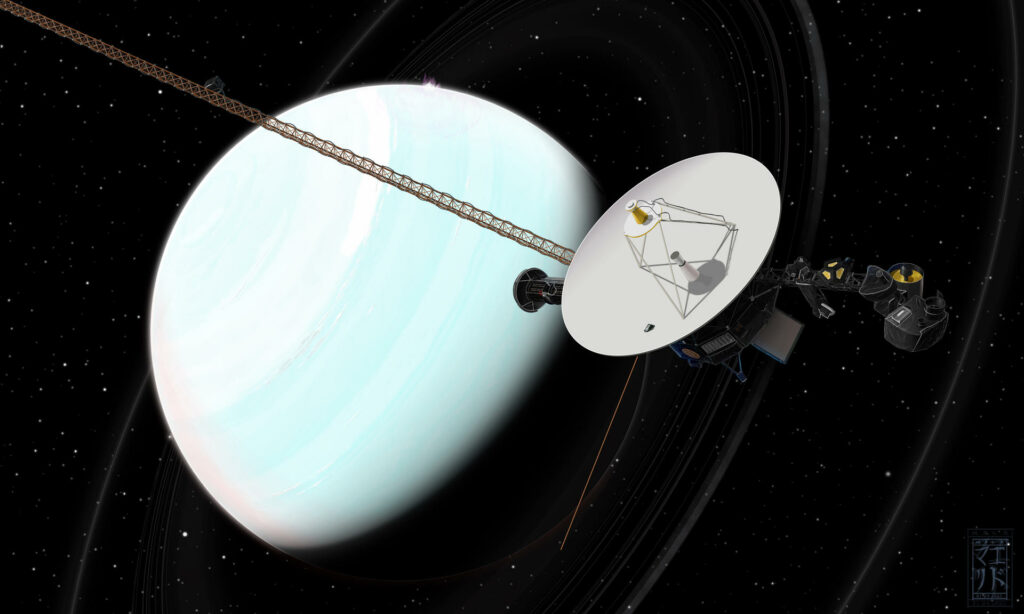Uranus is the seventh planet from the Sun, and it’s the third largest planet in our solar system – about four times wider than Earth. The diameter at its equator is 31,763 miles (51,120 kilometers).
Uranus is a very cold and windy planet. It is surrounded by faint rings, and more than two dozen small moons as it rotates at a nearly 90-degree angle from the plane of its orbit. This unique tilt makes Uranus appear to spin on its side.

Gravity: 8.87 m/s²
Orbital Period: About 84 Earth years (30,687 Earth days).
Length of Day: 0d 17h 14m
Radius: 25,362 km
Distance from Sun: 2.9314 billion km
Coordinates: RA 3h 9m 22s | Dec +17° 23′ 33″
Moons: With a total of 28 confirmed moons, Uranus primarily names them after characters found in, or referenced by, the works of William Shakespeare and Alexander Pope. These moons are categorized into three groups: thirteen inner moons, five major moons, and ten irregular moons. The inner and major moons follow prograde orbits and collectively fall under the classification of regular moons. In contrast, the irregular moons possess distant, highly inclined orbits, and predominantly exhibit retrograde motion.
Uranus is known for its unique and extreme tilt on its rotational axis, setting it apart from most other planets in our solar system. Unlike the planets that typically exhibit a relatively upright orientation as they orbit the Sun, Uranus appears to roll on its side, with an axial tilt of approximately 98 degrees. This extreme tilt means that Uranus essentially rotates almost perpendicular to the plane of its orbit around the Sun.
This extreme tilt has significant consequences for Uranus’ seasonal variations. As it orbits the Sun, different hemispheres of Uranus receive varying amounts of sunlight throughout its 84-year-long orbit. This results in long and distinct seasons, each lasting for about 21 years. During one half of Uranus’ orbit, a hemisphere experiences continuous sunlight, while the other half remains in prolonged darkness. Putting this into perspective, I am 21 years old! This would mean that the season would just now be changing, and I would have lived every day prior, in one season.
35 Years Ago: Voyager 2
In January of 1986, NASA’s Voyager 2 achieved the milestone of becoming the first and, to date, the only spacecraft to venture into the realm of Uranus, marking its second-to-last destination in the exploration of the outer solar system. The Jet Propulsion Laboratory, based in Pasadena, California, oversees both Voyager 1 and Voyager 2, which were launched in 1977 with the primary mission to investigate the outer planets. Originally intended for flybys of Jupiter and Saturn, Voyager 2 seized a rare opportunity presented by a planetary alignment occurring once every 175 years. After the successful exploration of Saturn and Titan by Voyager 1 in November 1980, NASA, on January 8, 1981, authorized Voyager 2 to follow a trajectory that, after its encounter with Saturn in August 1981, would lead it to traverse Uranus in 1986. If the spacecraft continued to operate effectively, it was planned to extend its journey further to include a flyby of Neptune in 1989.

As Voyager 2 drew nearer to Uranus, it captured detailed images of the planet’s prominent moons, including a remarkable close encounter with Miranda (moon) at a mere 18,000 miles – the nearest proximity to any celestial body Voyager 2 had achieved thus far. The transmitted images provided unexpected insights, showcasing each moon’s unique characteristics and revealing a greater degree of geological activity than initially anticipated.
Continuing its exploration, Voyager 2 executed its closest approach, coming within 50,700 miles above Uranus’ cloud tops. During this phase, the spacecraft passed behind the planet, utilizing its radio signals to gather valuable data about the upper atmosphere. Departing from Uranus, Voyager 2 sent back captivating images of the planet and its rings illuminated by the Sun, marking the conclusion of the encounter phase on February 25, 1986.
Throughout this mission, the spacecraft delivered over 7,000 photographs, uncovering 11 new moons, with some of the innermost ones intricately connected to the ring system. Additionally, two previously unknown rings encircling the planet were revealed, adding to the wealth of scientific knowledge obtained during this groundbreaking exploration.
https://science.nasa.gov/uranus/